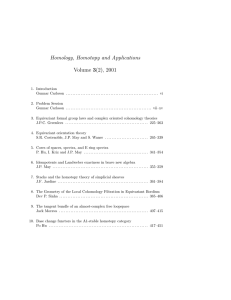Introduction 1 Brad Drew
advertisement
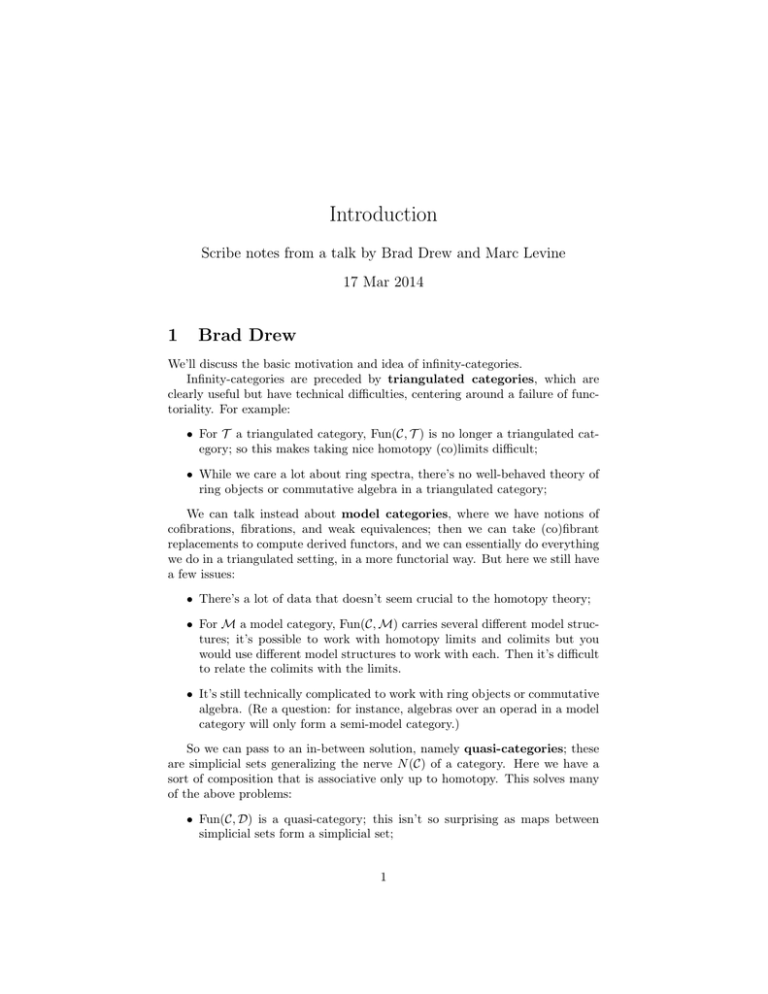
Introduction
Scribe notes from a talk by Brad Drew and Marc Levine
17 Mar 2014
1
Brad Drew
We’ll discuss the basic motivation and idea of infinity-categories.
Infinity-categories are preceded by triangulated categories, which are
clearly useful but have technical difficulties, centering around a failure of functoriality. For example:
• For T a triangulated category, Fun(C, T ) is no longer a triangulated category; so this makes taking nice homotopy (co)limits difficult;
• While we care a lot about ring spectra, there’s no well-behaved theory of
ring objects or commutative algebra in a triangulated category;
We can talk instead about model categories, where we have notions of
cofibrations, fibrations, and weak equivalences; then we can take (co)fibrant
replacements to compute derived functors, and we can essentially do everything
we do in a triangulated setting, in a more functorial way. But here we still have
a few issues:
• There’s a lot of data that doesn’t seem crucial to the homotopy theory;
• For M a model category, Fun(C, M) carries several different model structures; it’s possible to work with homotopy limits and colimits but you
would use different model structures to work with each. Then it’s difficult
to relate the colimits with the limits.
• It’s still technically complicated to work with ring objects or commutative
algebra. (Re a question: for instance, algebras over an operad in a model
category will only form a semi-model category.)
So we can pass to an in-between solution, namely quasi-categories; these
are simplicial sets generalizing the nerve N (C) of a category. Here we have a
sort of composition that is associative only up to homotopy. This solves many
of the above problems:
• Fun(C, D) is a quasi-category; this isn’t so surprising as maps between
simplicial sets form a simplicial set;
1
• There are nice universal properties;
• There’s a clean theory of commutative algebra.
Non-example. We will construct the stable motivic homotopy category SH(S) =
∆op PSh(Sm/S )[(P1S , ∞)−1 ]/( relations generated by A1 and the Nisnevich topology ).
Then we should have a universal property:
SH(S)∧
D⊗ (stable quasicat)
(Sm /S)×
Example. Let D⊗ = D(S(Q), Q)⊗ , the derived category of analytic sheaves of
Q vector spaces. Then a functor
ρB
SH(S)∧ −−→ D(S(Q), Q)⊗
arises from a morphism of sites
(Sm /S)Nis → AnSm/S(C).
(The latter is the site of analytic smooth schemes over the complex points of
S.)
Example. Let D⊗ = D(DS ), the derived category of D-modules (coefficients
for de Rham cohomology). We sholud end up with a functor from the stable
homotopy category to derived D-modules, but we don’t seem to know how to
build this with the language of model categories and Quillen functors. Quasicategories are an adequate language, giving a functor
SH(S)∧ → D(D(S)).
2
Marc Levine
This part will be on some of the historical background for A1 homotopy theory,
and perhaps Marc’s particular historical background with it.
We begin with the diagram:
H• (k)
Sm /k
Spc• (k)
SmProj /k
presheaves of
simplicial sets
on Sm /k
SH(S)
with S = Spec(k) the spectrum of a perfect field.
We study SmProj /k by means of “cohomological invariants”, such as:
2
∗
• k = C, X 7→ Hsing
(X(C), Z),
∗
• k of char. 0, X 7→ HdR
(X/k) = H∗ (XZar , Ω•X/k ),
∗
• for `, X 7→ Het
(X̄/k̄, Q` ).
These all fall into the family of Weil cohomology theories on SmProj /k.
We also have the “cycle classes”
Z n (X)
Z{W ⊆ X | W irred. of codim n}
cln
X
H 2n (X)
Weil cohomology
We can construct motives as a quotient of the category of correspondences:
Motk,H ← Cork,H [X],
where HomCork,H ([X], [Y ]) = Z dim X (X×Y )/ ∼H . In particular, if α ∈ EndCor ([X]),
then α2 = α; α is idempotent.
Conjecture. We can lift the Künneth components
i
αH
∈ H 2 dim X (X × X)
to idempotents αi ∈ HomCor (X, X), and H i (X) = ([X], αi ).
Assuming this conjecture, we will get a map Motk,CH → Motk,hom , where
the former are the motives formed by the rational equivalence relation.
We should define the Chow group:
CHn (X) = Z n (X)/Rn (X),
where
Rn (X) = {div(f ) | f ∈ k(W ), W ⊆ X of codimension n − 1}.
We have Weil cohomology for SmProj /k, but the extension of this to Sm /k
∗
is called Bloch–Ogers cohomology. For X/R, this looks like Het
(X, Q` (∗)),
∗
and for X/C, this is Hsing
(X, Z with mixed Hodge structure.
We have the mixed motives M Mk , due to Beilinson (at least). Two constructions have been given:
1. Bloch’s higher Chow groups
X 7→ Z q (X, ∗),
CHq (X, n) = Hn (Z q (X, ∗)) = H 2q−n (X, Z/Q),
3
2. Voevodsky’s triangulated category of motives, DM(k), where M (X) is the
motive associated to X, with motivic cohomology given by
H p (X, Z(Q)) = HomDM (k) (M (X), Z(q)[p]).
The connection with K-theory is as follows: as a definition due to Beilinson,
or a theorem due to others,
(q)
H p (X, Q(q)) = K2q−p (X).
And now we come to the homotopy theory. In ordinary stable homotopy
theory, we see D(Ab) as the category of HZ-modules in the stable homotopy
category. Here we have DM (k) as the homotopy category of Hmot Z-modules in
the stable motivic homotopy category. When k is of characteristic zero, we have
Motk,CH ,→ DM(k), so that this relates to our stable homotopy category. We
also have an adjunction between an Eilenberg–Maclane functor Ho(Hmot Z) →
SH(k) and the functor − ∧ Hmot Z : SH(k) → Ho(Hmot Z).
4


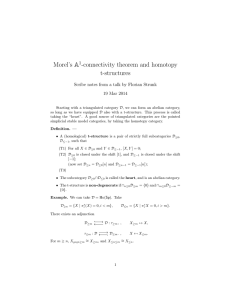


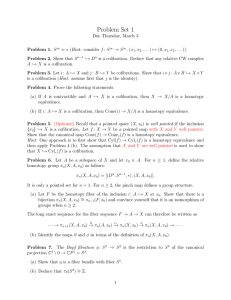
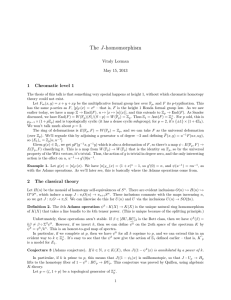

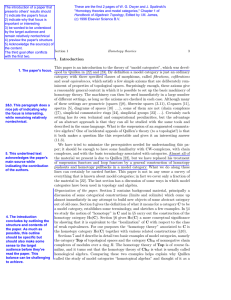
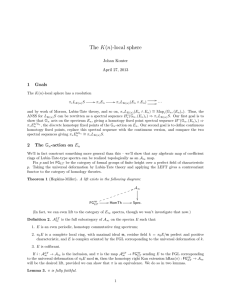
![ADDENDUM TO A MODULES” [HHA, V. 3 (2001) NO. 1, PP. 1-35]](http://s2.studylib.net/store/data/010469562_1-cf5094eeca4d38e330222cc27ac47611-300x300.png)
